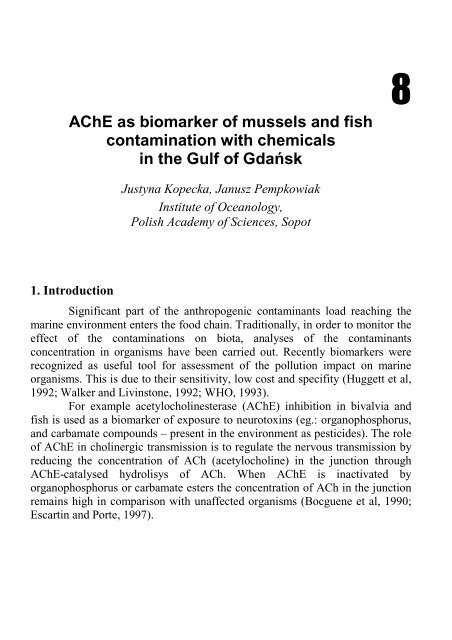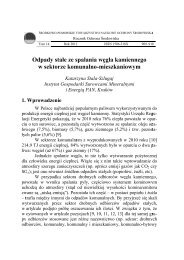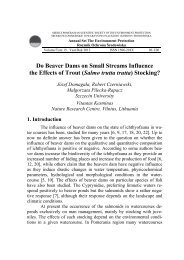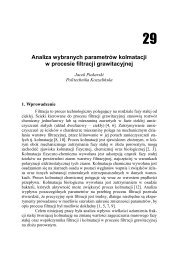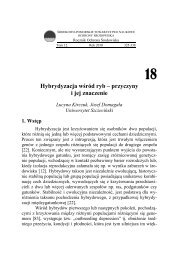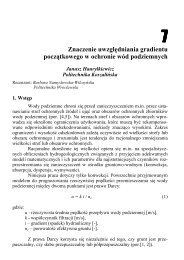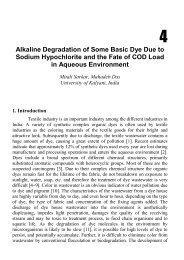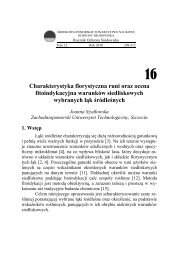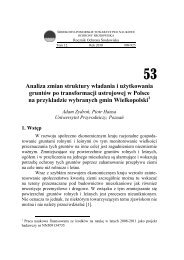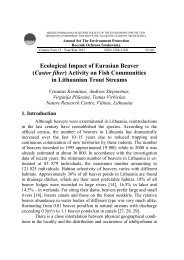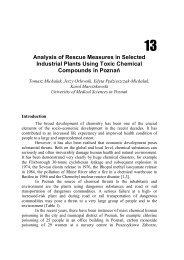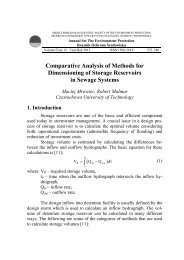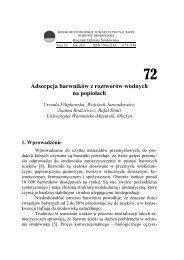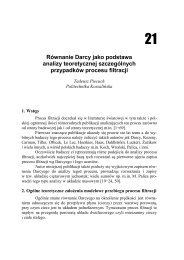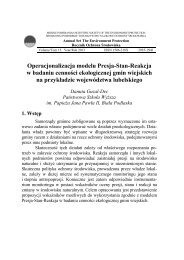Justyna Kopecka, Janusz Pempkowiak - Rocznik Ochrony Środowiska
Justyna Kopecka, Janusz Pempkowiak - Rocznik Ochrony Środowiska
Justyna Kopecka, Janusz Pempkowiak - Rocznik Ochrony Środowiska
Create successful ePaper yourself
Turn your PDF publications into a flip-book with our unique Google optimized e-Paper software.
AChE as biomarker of mussels and fish<br />
contamination with chemicals<br />
in the Gulf of Gdańsk<br />
1. Introduction<br />
<strong>Justyna</strong> <strong>Kopecka</strong>, <strong>Janusz</strong> <strong>Pempkowiak</strong><br />
Institute of Oceanology,<br />
Polish Academy of Sciences, Sopot<br />
8<br />
Significant part of the anthropogenic contaminants load reaching the<br />
marine environment enters the food chain. Traditionally, in order to monitor the<br />
effect of the contaminations on biota, analyses of the contaminants<br />
concentration in organisms have been carried out. Recently biomarkers were<br />
recognized as useful tool for assessment of the pollution impact on marine<br />
organisms. This is due to their sensitivity, low cost and specifity (Huggett et al,<br />
1992; Walker and Livinstone, 1992; WHO, 1993).<br />
For example acetylocholinesterase (AChE) inhibition in bivalvia and<br />
fish is used as a biomarker of exposure to neurotoxins (eg.: organophosphorus,<br />
and carbamate compounds – present in the environment as pesticides). The role<br />
of AChE in cholinergic transmission is to regulate the nervous transmission by<br />
reducing the concentration of ACh (acetylocholine) in the junction through<br />
AChE-catalysed hydrolisys of ACh. When AChE is inactivated by<br />
organophosphorus or carbamate esters the concentration of ACh in the junction<br />
remains high in comparison with unaffected organisms (Bocguene et al, 1990;<br />
Escartin and Porte, 1997).
2.1. Materials and methods<br />
2.1. Sampling strategy<br />
100<br />
<strong>Justyna</strong> <strong>Kopecka</strong>, <strong>Janusz</strong> <strong>Pempkowiak</strong><br />
Organisms from two species of bivalvia (Macoma balthica, Mytilus<br />
trossulus) and flounder (Platichthys flesus) were used as biomonitoring organisms<br />
of coastal pollution in this study. The distribution of sampling stations where the<br />
organisms were collected, in the Gulf of Gdańsk is shown in Fig. 1.<br />
Fig. 1. Distribution of sampling stations in the Gulf of Gdańsk<br />
Rys. 1. Rozmieszczenie stacji pomiarowych w Zatoce Gdańskiej<br />
All sampling grounds are distributed inside the Gulf of Gdańsk, except<br />
a reference station – located on the ‘open sea’ side the Hel Peninnsula. In the<br />
Gulf of Gdańsk 4 sampling grounds were selected:<br />
off Mechelinki – the most polluted site, the sewage outflow from the<br />
Gdynia WWTP is located there,<br />
off Sopot – the recreational and touristic area,<br />
close to the mouth of the Vistula river – in this site the influence of the<br />
Vistula river is at its maximum,<br />
on the ship route to the ports (TOR).<br />
Środkowo-Pomorskie Towarzystwo Naukowe <strong>Ochrony</strong> <strong>Środowiska</strong>
AChE as biomarker of mussels and fish contamination with chemicals ...<br />
The organisms were collected in 2001 (March and November), and<br />
2002 (March). The mussels (of uniform shell length: M. trossulus 35±5 mm,<br />
M.balthica >15 mm) were catched using a drag net from the research vessel<br />
“Oceania” (IO PAS, Sopot). Catching was towed at 1,5÷2 knots for 15÷20 min<br />
so as to minimize stress to catch. The flounder (20 females and 3÷10 males,<br />
body length 20÷30 cm) were collected by local fishermans using flounder nets<br />
(φmesh = 60mm).<br />
In the laboratory notes were taken on flounder condition, length, sex,<br />
weight (whole and empty fish, liver, gonads and spleen) and degree of<br />
parasitisms.<br />
Different tissues sectioned from the 5 pooled organisms were used as<br />
source of samples: gills from M. trossulus, foot from M.balthica (Mora et al,<br />
1998; Mora et al, 1999), and muscle tissues from flounder (Kirby et al, 2000;<br />
Schneider et al, 2000). The sectioned organs were immediately transferred to<br />
liquid nitrogen and then kept in deep freezer -80°C.<br />
2.2. Extraction – fraction S9<br />
100÷200 mg wet weight aliquots of the desired tissue samples were<br />
homogenized in 0,02M phosphate buffer (pH = 7,0; 0,1% Triton X-100) in ratio<br />
1/4 (weight/volume) using an electric homogenizer (homogenization was<br />
performed twice, each time for 20 sec, in glass vessels kept in ice). Then the<br />
homogenate was centrifuged at 10000 g in the temperature of 4°C for 20 min.<br />
The supernatant (fraction S9) was stored at -80°C before the biochemical<br />
measurements. The procedure is described in detail by Bocquene and Galgani<br />
(1998).<br />
2.3. Protein determination<br />
The method described by Bradford (1976) was used for quantitative<br />
determination using BSA (bovine serum albumin) as the protein standard, after<br />
having been adapted to be used with a microplate reader “Genios” (TECAN).<br />
For each microplate well the following solutions were added: 10 μl of diluted<br />
S9 extract (dilution factor with destilated water applied to the samples was – for<br />
fish: 1/50; – for mussels: 1/10), 90 μl destilated water and 280 μl Bradford<br />
reagent (diluted 1/5). Absorbance was read at λ = 595 nm and the protein<br />
concentration were calculated from the standard curve.<br />
2.4. Measurement of AChE<br />
The method for measurements of AChE activity in the microplate<br />
reader, adopted from Bocquene and Galgani (1998), was used. The following<br />
proportions of solutions were applied.<br />
Środkowo-Pomorskie Towarzystwo Naukowe <strong>Ochrony</strong> <strong>Środowiska</strong> 101
102<br />
<strong>Justyna</strong> <strong>Kopecka</strong>, <strong>Janusz</strong> <strong>Pempkowiak</strong><br />
Solutions<br />
– (all were adapted to<br />
Blank Mussel sample Fish sample<br />
room temperature) 5 replicates 3 replic. 3 replic.<br />
0,02M Phosphat buffer<br />
+ 0,1% Triton X-100<br />
350 μl 330 μl 340 μl<br />
Sample – fraction S9 – 20 μl 10 μl<br />
0,01M DTNB<br />
(in 0,1M Tris/HCL,<br />
pH = 8.0)<br />
20 μl 20 μl 20 μl<br />
Incubation 5 min<br />
0,1M ACTC<br />
(in Aqua dest)<br />
10 μl 10 μl 10 μl<br />
This was followed by absorption measurement at λ=405nm in 4 kinetic<br />
intervals (0, 1, 2, 3 min)<br />
3. Results and discussion<br />
All pooled samples of mussels and individuals fish had AChE activity<br />
[nmol/min · mg protein] in the following ranges: 29÷83 (in M.balthica), 12÷38<br />
(in M.trossulus) and 94÷185 (in flounder). The obvious, and already noticed<br />
species dependence of the levels, Bocquene and Galgani (1998) can be noticed.<br />
AChE activities in M. balthica were the lowest in sites close to the Hel<br />
Peninsula in all sampling periods (Fig. 2).<br />
In this area the highest concentrations of pollution in sediment and<br />
water had been measured (Sapota, 2000). The highest mean values of AChE<br />
were found in whole tissue of M. balthica from the Tor station (80÷83<br />
nmol/min · mg protein).<br />
The lowest mean value of AChE activity in M. trossulus were observed<br />
near the Mechelinki and Jastarnia stations (15÷20 nmol/min · mg protein) – Fig. 3.<br />
This area is regarded as a very polluted one (Sapota, 2000, Potrykus et<br />
al., 2003) – due to sewage dicharges. In the sampling site near Sopot (GG3) the<br />
higher values of AChE activity in M. trossulus (ca 38 nmol/min · mg protein)<br />
were observed.<br />
In female flounder mean values of AChE activity higher, than in males,<br />
were found (Fig. 4).<br />
Środkowo-Pomorskie Towarzystwo Naukowe <strong>Ochrony</strong> <strong>Środowiska</strong>
AChE as biomarker of mussels and fish contamination with chemicals ...<br />
AChE activity<br />
[nmol/min*mg protein]<br />
100<br />
90<br />
80<br />
70<br />
60<br />
50<br />
40<br />
30<br />
20<br />
10<br />
0<br />
Macoma baltica-Gulf of Gdańsk<br />
March 2001<br />
October 2001<br />
March 2002<br />
GG2 Tor Hel GG1<br />
Station<br />
Fig. 2. Levels of AChE activity in Macoma balthica from the Gulf of Gdańsk<br />
Fig. 2. Aktywność AChE w małŜu Macoma balthica z Zatoki Gdańskiej<br />
AChE activity<br />
[nmol/min*mg protein]<br />
100<br />
90<br />
80<br />
70<br />
60<br />
50<br />
40<br />
30<br />
20<br />
10<br />
0<br />
Mytilus trossulus-Gulf of Gdańsk<br />
GG2 GG3 Oksywie GG1 Jastarnia Reference<br />
Station<br />
March 2001<br />
October 2001<br />
March 2002<br />
Fig. 3. Levels of AChE activity in Mytilus trossulus from the Gulf of Gdańsk<br />
Rys. 3. Aktywność AChE w małŜu Mytilus trossulus z Zatoki Gdańskiej<br />
Środkowo-Pomorskie Towarzystwo Naukowe <strong>Ochrony</strong> <strong>Środowiska</strong> 103
104<br />
AChE activity<br />
[nmol/min*mg protein]<br />
Site<br />
300<br />
250<br />
200<br />
150<br />
100<br />
50<br />
0<br />
<strong>Justyna</strong> <strong>Kopecka</strong>, <strong>Janusz</strong> <strong>Pempkowiak</strong><br />
Flounder (Platichthys flesus) - Gulf of Gdańsk<br />
Female<br />
Male<br />
GG1 GG2 GG3 Tor GG1 GG2 GG3 Tor GG1 GG2 GG3 Tor<br />
Spring 2001<br />
Autumn 2001<br />
Fig. 4. Level of AChE activity in flounder from the Gulf of Gdańsk<br />
Rys. 4. Aktywność AChE w storni z Zatoki Gdańskiej<br />
Spring 2002<br />
The lowest mean values in flounder were found in spring 2002 in all<br />
sampling sites. At that time very low water temperature was recorded. It could<br />
have influenced level of AChE activity (Bocquene and Galgani, 1998). AChE<br />
activities in individual flounders were different in all sites and periods (this<br />
explains high standard deviations). The phenomenon can be also attributed to<br />
the age, sex, and environmental factors.<br />
4. Conclusions<br />
Levels of AChE activity are thought to be a useful indicator of<br />
biological responses in organisms (mussels and fish) to pollution.<br />
Inhibition of AChE activity in tissue has been proposed as a useful<br />
biomarker of an effective exposure to organophosphates and carbamates<br />
(Bocquen÷ and Galgani, 1998; Schneider et al, 2000). Since the sources of<br />
contaminants are rather localised (mouth of the Vistula due to runoff, ports,<br />
sewage discharges) well-developed gradients of organic pollutants in organisms<br />
have been recorded. This is well documented and confirmed in this, biomarker<br />
oriented, study.<br />
5. Acknowledgement<br />
This work was financially support from FP5 Program, Biological<br />
Effects of Environmental Pollution – BEEP.<br />
Środkowo-Pomorskie Towarzystwo Naukowe <strong>Ochrony</strong> <strong>Środowiska</strong>
AChE as biomarker of mussels and fish contamination with chemicals ...<br />
References<br />
1. Bocquen÷ G., Galgani F.: Biological effects of contaminants: Cholinoesterases<br />
inhibition by organophosphate and carbamate compounds. ICES Techniques in<br />
Marine Environmental Sciences, No 22, International Council for the Exploration of<br />
the Sea, 1÷13. 1998.<br />
2. Dellali M., Barcelli M.G., Romeò M., Aissa P.: The use of acetylocholinoesterases<br />
activity in Ruditapes decussates and Mytilus galloprovincialis in the biomonitoring of<br />
Bizerta Lagoon. Comparative Biochemistry and Physiology (Part C) 130, 227÷235.<br />
2001.<br />
3. Galgani F., Bocquen÷ G.: Molecular Biomarkers of Exposure of Marine Organisms<br />
to Organophosphorus Pesticides and Carbamates. Biomarkers, 23, 113÷134. 1998.<br />
4. Huggett R.J., Kimerle R.A., Mehrle Jr P.M., Bergman H.L.: Biomarkers:<br />
Biochemical, Physiological and Histological Markers of Anthropogenic Stress.<br />
SETAC Special Publications Series, Lewis Publisher, 5÷17. 1992.<br />
5. Kirby M.F., Morris S., Hurst M., Kirby S.J., Neall P., Tylor T., Fagg A.: The Use<br />
of Cholinoesterase Activity in Flounder (Platichthys flesus) Muscle Tissue as<br />
a Biomarker of Neurotoxic Contamination in the UK Estuaries, Marine Pollution<br />
Bulletin, 40 (9), 780÷791. 2000.<br />
6. <strong>Kopecka</strong> J., <strong>Pempkowiak</strong> J.: poster presentation in the SETAC 2002 Conference:<br />
“AChE as biomarker of mussels and fish contamination with chemicals in the Gulf of<br />
Gdańsk”; SETAC 2002, Book of Abstracts, 223. 2002.<br />
7. Mora P., Michel X., Narbonne J.F.: Cholinoesterases activity as potential<br />
biomarker in two bivalves, Environmental Toxicology and Pharmacology, 7,<br />
253÷260. 1999.<br />
8. Mora P., Fournier D., Narbonne J.F.: Cholinoesterases from the marine mussels<br />
(Mytilus galloprovincialis Lmk. And Mytilus edulis L. and from the freshwater<br />
bivalve Corbicula fluminea Mőller, Comparative Biochemistry and Physiology (Part<br />
C) 122, 353÷361. 1999.<br />
9. Narbonne J.F., Daubeze M., Clerandau C., Garrigues P.: Scale of classification<br />
based on biochemical markers in mussels: application to pollution monitoring in<br />
European coasts, Biomarkers, 4 (6), 415÷424. 1999.<br />
10. Potrykus J., Albalat A., <strong>Pempkowiak</strong> J., Porte C.: Content and pattern of organic<br />
pollutants (PAHs, PCBs and DDT) in blue mussels (Mytilus trossulus) from the<br />
southern Baltic Sea, Oceanologia, 45 (2), 337÷355. 2003.<br />
11. Sapota G.: Bioakumulacja węglowodorów chlorowanych w sieci troficznej Zatoki<br />
Gdańskiej, PhD Tesis, Gdańsk Univ. 137 pp. 2000.<br />
12. Schneider R., Schiedek D., Petersen G.I.: Baltic cod reproductive impairment:<br />
varian organo-chlorine levels, hepatic EROD activity, muscular AChE activity,<br />
developmental success of eggs and larvae, challenge tests; Temporal and Spatial<br />
Trends in the Distribution of Contaminants and their Biological Effects in the ICES<br />
Area (S), ICES CM, S:09. 2000.<br />
13. Walker C.H., Livingstone D.R.: Persistent pollutants in marine ecosystems, SETAC<br />
Special Publications Series, Pergamon Press, 3÷35. 1992.<br />
14. WHO, Biomarkers and Risk Assessment: Concepts and Principles. International<br />
Programme of Chemical Safety. World Health Organization, Vammole 1993, 82 pp.<br />
1993.<br />
Środkowo-Pomorskie Towarzystwo Naukowe <strong>Ochrony</strong> <strong>Środowiska</strong> 105
Streszczenie<br />
106<br />
<strong>Justyna</strong> <strong>Kopecka</strong>, <strong>Janusz</strong> <strong>Pempkowiak</strong><br />
AChE jako biomarker skaŜenia chemikaliami<br />
małŜy i ryb z Zatoki Gdańskiej<br />
W ciągu ostatnich kilkunastu lat udokumentowano w środowisku Morza<br />
Bałtyckiego spadek stęŜenia WWA, PCB, dioksyn i metali cięŜkich. Jednak ze względu<br />
na wysoką toksyczność w odniesieniu do organizmów oraz ze względu na trwałość<br />
w środowisku morskim i akumulację w łańcuchu troficznym, naleŜą one do najczęściej<br />
badanych zanieczyszczeń w programie środowiskowym. Jako metodę oceny stanu<br />
środowiska tradycyjnie stosuje się pomiar stęŜenia zanieczyszczeń w tkance miękkiej<br />
organizmów morskich. Jednak pomiar ten nie wiąŜe się bezpośrednio z oceną skutków ich<br />
akumulacji w organizmach Ŝywych<br />
W ciągu ostatnich 15÷20 lat jako metodę toksykologii środowiskowej słuŜącą do<br />
bardziej kompleksowej oceny stanu środowiska, wprowadzono pomiar biologicznych<br />
skutków zanieczyszczenia biocenozy – tzw. biomarkerów. Jako wskaźniki stosuje się tu<br />
zmiany w funkcjonowaniu organizmów na poziomie biochemicznym, fizjologicznym<br />
i histologicznym. Pozwalają one bezpośrednio określić wpływ zanieczyszczeń na<br />
organizmy Ŝyjące w środowisku wodnym i mogą być one stosowane do pomiarów reakcji<br />
organizmów na chemiczne czynniki stresujące. Najwcześniej skutki biologiczne ujawniają<br />
się na poziomie komórkowym. Na poziomie organów i organizmów indywidualnych<br />
moŜna zauwaŜyć zmiany chorobowe, zaburzenia odporności i fizjologii. Śmierć<br />
organizmów, a tym samym spadek populacji, mniejsza bioróŜnorodność, i w efekcie –<br />
degradacja środowiska przyrodniczego spowodowana jest długoterminowym efektem<br />
ekspozycji organizmów na zanieczyszczenia.<br />
Celem tej pracy było określenie poziomu Acetylocholinoesteracy (AChE) –<br />
enzymu współodpowiedzialnego za przekazywanie impulsów w systemie nerwowym<br />
w małŜach i rybach z Zatoki Gdańskiej. Aktywność AChE ulega obniŜeniu w organizmach<br />
eksponowanych na związki (np. pestycydy) fosforoorganiczne, i karbaminianowe.<br />
Organizmy pobierano z rejonów przybrzeŜnych Zatoki Gdańskiej: Mechelinki,<br />
Sopot, ujście Wisły, z centralnej części Zatoki oraz punktu referencyjnego połoŜonego na<br />
zewnątrz Półwyspu Helskiego. Badania wskaźników substancji szkodliwych objęły<br />
organizmy z dwóch gatunków małŜy (Macoma balthica i Mytilus trossulus) i jednego<br />
gatunku ryb – storni (Platichthys flesus). Analizie poddano wybrane tkanki (skrzela<br />
w M. trossulus, noga w M. balthica oraz mięśnie w storni) zostały zmierzone aktywności<br />
AChE (acetylocholinoesterazy).<br />
Analiza zbioru wyników aktywności (AChE) wykazała zmienność gatunkową<br />
stęŜenia AChE, róŜnice w AChE w organizmach męskich i Ŝeńskich, i znaczną zmienność<br />
indywidualną. Nie stwierdzono statystycznie istotnych zmian w zmienności geograficznej<br />
i sezonowej.<br />
Natomiast w aktywności AChE w małŜach nie obserwuje się istotnych róŜnic.<br />
Środkowo-Pomorskie Towarzystwo Naukowe <strong>Ochrony</strong> <strong>Środowiska</strong>


